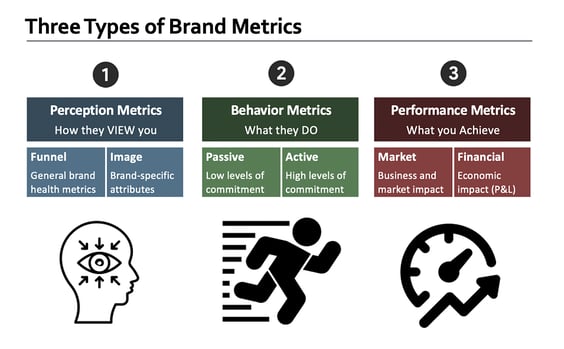
In a previous post, Clearing the Confusion Around Brand Measurement, we discussed three types of metrics that comprise an effective brand measurement system — perception, behavior, and performance. In general, the first two categories are about the customer and the brand. The third one considers the impact of the first two categories on the organization itself.

Diagnostic metrics are about how customers view the brand. Brand funnel metrics are the most common and help marketers understand the underlying health of their brands. Examples include:
- Awareness
- Consideration
- Preference
- Purchase Intent
- Favorability
- Satisfaction
Behavior metrics are what consumers actually do — the actions they take. Examples include:
- Browsing a website
- Reading a review
- Downloading an article
- Submitting a “Contact Us” form
- Requesting information
Performance metrics are essential for connecting brand investments, initiatives, and activities to the financial results of the business. Marketers should consider these metrics from both a nonfinancial and financial perspective.
The optimal way to approach brand measurement varies by company and industry. The approach for any company will differ based on its goals, but all companies can follow these guiding principles, which tend to hold true regardless of measurement objectives or industry.
-
USE A MIX OF METRIC TYPES
Marketers should include a mix of the different types of metrics that have been described. The real power in measurement comes when a marketer can look at the brand and the business and gain a holistic perspective with a variety of data points.
-
BENCHMARK AGAINST THE COMPETITION
Brand metrics are not effective without a relevant frame of reference, so marketers must choose other brands against which to track and compare performance.
-
ESTABLISH BASELINES AND TARGETS
Companies should establish baselines and targets for brand measurement. Any metric lacks meaning without context. This aspect of a measurement system can help elevate it from diagnostic to prescriptive.
-
CORRELATE BRAND PERFORMANCE WITH BUSINESS RESULTS
Effective brand measurement aims to improve business performance and enhance marketing accountability. A measurement system should include brand and business performance metrics in order to accomplish these objectives. Business performance metrics should include key performance indicators like unit volume, sales leads, and market share. Ideally, they should also include financial metrics like revenue, profit, and margin.
-
KEEP IT SIMPLE
Allowing systems to become too complex to manage is one of the most common pitfalls of brand measurement. When this happens, marketers may lose confidence in the credibility of their systems. However, some measurement is almost always better than none. It is thus important that the system is realistic in both its scope and pace. This could mean limiting a metrics dashboard to include only the most important metrics at first. Marketers could then increase their measurement efforts gradually over time, adding new capabilities as their proficiency increases.
Because every company is different, no two approaches to brand measurement will be identical. These guiding principles can apply to a variety of situations, though, and provide an excellent starting point for marketers to begin measuring their brand-building efforts more effectively.
A Final Word on Accountability
The importance of marketing accountability in the digital age cannot be overstated. An effective measurement system plays a vital role in achieving that accountability. As such, CMOs need to become more adept in brand measurement. They must move beyond merely tracking and diagnosing in brand- related measurement so they can see how their brands and the programs and initiatives behind them impact business results.
Recent Posts
Posts by Topics
- Brand Strategy (57)
- Brand Strategy Consulting (28)
- Brand Differentiation (27)
- Customer Experience (24)
- Brand Positioning (22)
- Marketing Strategy (9)
- Brand Extension Strategy (8)
- Customer Behavior (8)
- Brand Architecture Strategy (7)
- Brand Extension (7)
- Brand Growth (7)
- Brand Portfolio & Architecture (7)
- Brand Purpose (7)
- Brand Value Proposition (7)
- Brand Engagement (6)
- Brand Portfolio Strategy (6)
- Brand Storytelling (6)
- Rebranding Strategy (6)
- Brand Awareness (5)
- Brand Image (5)
- Branding (5)
- Rebranding (5)
- Technology (5)
- B2B Brand Strategy (4)
- Brand Experience (4)
- Value Proposition (4)
- Brand Extendibility (3)
- Brand Metrics (3)
- Brand Repositioning (3)
- Corporate Branding (3)
- Differentiation Strategy (3)
- Measurement & Metrics (3)
- Brand Engagement Strategy (2)
- Brand Portfolio (2)
- Brand Promise (2)
- Brand Voice (2)
- Digital Marketing (2)
- Digital and Brand Experience (2)
- Employee Brand Engagement (2)
- Brand Architecture (1)
- Brand Development (1)
- Brand Equity (1)
- Brand Identity (1)
- Brand Measurement (1)
- Brand Name (1)
- Brand Strategy Consultants (1)
- Brand Strategy Firms (1)
- Digital Strategy (1)
- Internal Branding (1)
- Messaging (1)


